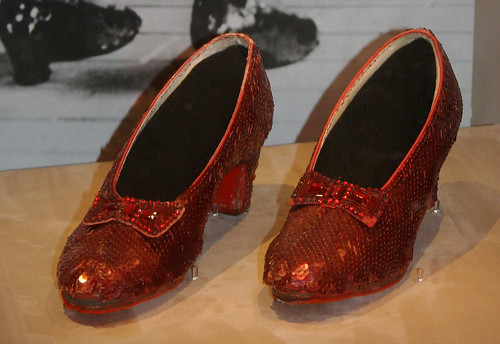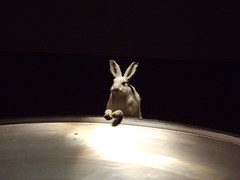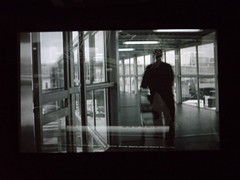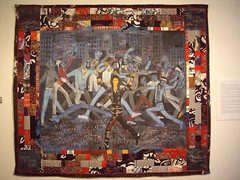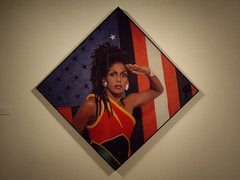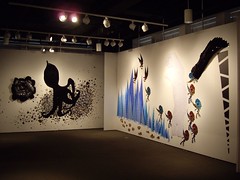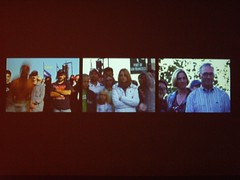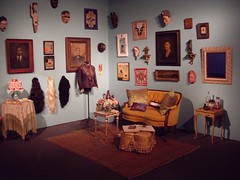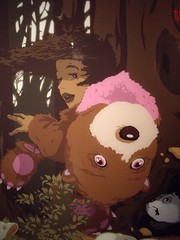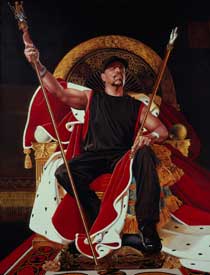Monday, December 01, 2008
Slumdog Millionaire - A Film by Danny Boyle
Slumdog Millionaire is the story of Jamal Malik (British actor Dev Patel), an 18-year-old Muslim from the Juhu slum in Mumbai who inexplicably makes it to the final round of the Indian version of Who Wants to Be a Millionaire? Barely educated and working as a chaiwallah at a call center, Jamal is an unlikely trivia champion. So unlikely, that the Mumbai police have hauled him in for questioning on the eve of his chance to win 20 million rupees (about US $400K). The investigator, played by the great Indian actor Irrfan Khan, has no sympathy for this young man at first, but comes to realize that Jamal has remained honest and kind despite a life spent as an orphan on the harsh city streets.
Despite his chronic optimism, Jamal is not a Candide, foolishly faithful in the innate goodness of others. Estranged from his only family, brother Salim (Madhur Mittal), he is in single-minded pursuit of his childhood love, Latika, played by newcomer and Mumbai native Freida Pinto. Jamal will stop at nothing to rescue her from the gangsters and thugs who are keeping them apart. Salim and Latika represent the two possible options for poor, orphaned city kids, which Jamal rejects to make his own way. Salim is driven by power, at the expense of his own family. Latika is a fatalist, resigned to a life as the plaything of others. Only Jamal has the vision to exceed society's low expectations of him.
I won't give away the story, because you should really go out and see this remarkable film. It's not yet in wide release, but has hit the biggest markets already and will be opening in smaller cities throughout December. Distributor Fox Searchlight has made a puzzling decision to limit the release of this film despite its wide appeal and substantial buzz -- one which I hope they rethink considering Slumdog Millionaire's strong per-screen box office performance.
The film is particularly poignant in light of last week's horrific attacks in Mumbai, which the perpetrators have disingenuously tried to cast as a righteous response by Indian Muslims to poor treatment within India. Slumdog Millionaire does not shy away from depicting sectarian violence, but it shows convincingly why that argument is bunk. The sequence that deals with the massacre of Muslims during the 1993 Bombay Riots is absolutely gut-wrenching. However, poverty affects Indians of all faiths. Jamal's true love Latika is a Hindu, though this is immaterial to the story. What the film really shows is how the poor are abused and can be manipulated by unscrupulous and greedy gangsters. It makes no difference whether those criminals are motivated by money or by religion -- the quest for power makes monsters.
For those who would ask, India's Who Wants to Be a Millionaire? was a real phenomenon. Known in Hindi as Kaun Banega Crorepati (कौन बनेगा क्रोरेपति), the show rekindled India's love affair with Amitabh Bachchan in the early 2000s, and fueled a rivalry between the lauded actor and today's top Bollywood star Shah Rukh Khan. One of the best things about Slumdog Millionaire is how the film shows India today, in all its contradictory glory. TV is everywhere, while ancient traditions still persist. Rampant development is unhampered by planning or organization.
More on this tomorrow, when I will finally share some details of my trip to India in October. Stay tuned.
Thursday, November 27, 2008
Thanks
As I've posted here before, Todd Blair is a dear friend and former colleague who suffered a traumatic brain injury in September of 2007. His injuries were very serious and his prognosis was at best cautiously optimistic. I am happy to report after seeing Todd today that he is recovering incredibly well, and has come much farther than anyone could have hoped since beginning in-home care early this summer. There is still a long way to go. Still, Todd and his tenacious goddess of a wife, Alex, will make it there, and this makes me believe that we will all get through these trying times in one piece.
Thanksgiving is one of my favorite holidays, because its spirit is universal. Though it may have been taught to us in school as a dirty trick played by the Pilgrims on the Indians, I prefer to think of it as our least jingoistic, Christerrific national holiday. I look forward to a day of friends and food (after a morning of cooking and cleaning).
One thing I am not thankful for is the horrible news coming from Mumbai today. Even as we count our blessings, we ought as well to take a moment to remember those who are suffering today and every day, to think about how we can help others who have less to be thankful for.
Saturday, November 15, 2008
The Lost Years and Last Days of David Foster Wallace
"Basically it was the same symptoms all along: this incredible sense of inadequacy, panic. He once said to me that he wanted to write to shut up the babble in his head. He said when you're writing well, you establish a voice in your head, and it shuts up the other voices. The ones that are saying, 'You're not good enough, you're a fraud.'"
"I think one of the true ways I've gotten smarter is that I've realized that there are ways other people are a lot smarter than me. My biggest asset as a writer is that I'm pretty much like everybody else. The parts of me that used to think I was different or smarter or whatever almost made me die."
"There is, in writing, a certain blend of sincerity and manipulation, of trying always to gauge what the particular effect of something is gonna be [...] It's a very precious asset that really needs to be turned off sometimes. My guess is that writers probably make fun, skilled, satisfactory, and seemingly considerate partners for other people. But that the experience for them is often rather lonely."
This story made me so sad that it's taken me almost two weeks to finish reading it. It is such a tragedy when a person takes his or her own life, even more so when he or she has a great deal to offer the world, and especially when the reason is pharmaceutical as it so often is.
I hope that by reading about what Wallace went through, the rest of us who share a lot of his fears and anxieties about our own art and lives might be spared a little bit of pain. In return, we might push ourselves a little bit harder, like Wallace did, to make something truly original.
Wednesday, November 12, 2008
Lehman Brothers to Auction Art Assets
The Guardian is reporting that Lehman Brothers is planning to sell off about $8 million worth of art, including a lot of modern and contemporary work.
"According to Bloomberg, the Lehman collection has more than 3,500 pieces. The Neuberger Berman collection has another 900 works, including pieces by Marlene Dumas, Andreas Gursky, Takashi Murakami, Neo Rauch and Sam Taylor-Wood."
The story also states that companies that bought up parts of Lehman Brothers, such as Barclays and Bain Capital, will be allowed to keep the artworks located on the premises of Lehman Brothers divisions they now own for a full year. After that time, they will be permitted to cherry-pick which artworks to keep, and the rest will go on auction.
Finally, the Guardian reports that Lehman Brothers is seeking court permission to pay its art storage facilities and art handlers, so that the work these companies have on site can be released for sale. Right now, those warehouses are (wisely) hanging onto the LB assets in their possession in case they don't get paid.
It will be interesting to watch how this plays out, particularly since auction sales this fall have already dropped dramatically. Will Lehman be able to successfully unload the collection? Will a few moneyed people who kept cash under their mattresses be able to buy it up for a song? One thing's clear, which is that the flood of art on the auction market is going to further undercut gallery business. Will it be good for the museums, who often find they can't afford the best examples of work for their collections? We'll have to wait and see.
Monday, November 10, 2008
High Desert Test Sites
The experience of walking and driving through the desert landscape was incredible. The weather was marvelously varied, and the clouds and sandy mountains were constantly changing. I felt, much as I did when visiting the Spiral Jetty, that the real artistry was done by nature and the artist's gesture was little more than a marker pointing out a site for engagement. That said, I thought most of the artists could have tried harder to make their markers more meaningful.
Ann Magnuson's "Time Traveling Hooker" installation in room 8 at the Joshua Tree Inn was the best of the weekend's installations. It was powerful in that it evoked a real event, the death of musician Gram Parsons, in the place where it happened. Audio, video and installation elements combined to make an abstract historical footnote into something tangible, and charged the space with life and memory.
The Noah Purifoy Foundation was another highlight. Purifoy has created a permanently installed sculpture garden using recycled and waste materials, that has a wonderful junkyard sensibility. The sculptures are largely quasi-architectural environments, built into the landscape in an echo of some of the eroded structures found scattered around the Joshua Tree area. They are naive in a thoughtful way, and succeed as anti-monumentalist art in a way that most of the works in last year's Unmonumental at the New Museum failed to do.
Otherwise, the projects ranged from mildly unsuccessful to nonexistent. Yoshua Okon's "White Russians" gathering at a local home had a strangely unfriendly vibe considering they were handing out drinks in a private household. The locals were welcoming but the Angelenos seemed to have brought their bad attitudes with them. The whole project felt condescending to the rural types who were the hosts, as if we city folk were being invited into their homes to laugh at their unsophistication. The dogs were sweet though.
Marnie Weber and the Spirit Girls' performance was pleasingly odd and theatrical, and the band's musicianship was tight. Weber has an unfortunate voice and limited lyrical skills, but she looks good in costumes. I imagine it was a bit like watching the Velvet Underground perform with Nico.
The installation by Julia Scher, which consisted of a perimeter of signs announcing contamination in the landscape, and the nearby one by Joel Kyack involving an illuminated mineshaft and a bifurcated miner, were entertaining. Projects by Alice Konitz and Thom Merrick were not there when we went to check them out on Sunday. We got to explore some amazing spots while looking for them. In truth, we didn't miss the art much.
Photos from the weekend can be viewed here.
Friday, November 07, 2008
ICA Live and Media Arts Department Cancelled
From the now-notorious internal memo that's been making the rounds:
"New media based arts practice continues to have its place within the arts sector. However it's my consideration that, in the main, the art form lacks the depth and cultural urgency to justify the ICA's continued and significant investment in a Live & Media Arts department."
Perhaps the ICA's decision could be seen as reflective of a broader shift in focus, from delineated New Media programming toward a new emphasis on integrating intermedia and cinema, that is happening throughout the contemporary art sphere. However, Eshun's confrontational and dismissive language suggests that this decision may have more to do with current art-world fashions than with any real concerns about this medium. Considering that the department's current exhibition features Rafael Lozano-Hemmer, whose contribution to the Mexican Pavilion at last year's Venice Biennale made a huge splash, even this argument is perplexing.
The saddest part of the whole sorry affair is that the ICA has historically been a home for some of the most innovative, least tech-nerdy media art installation projects. The department has consistently challenged assumptions about how an exhibition space might be used. For example, in the current project Dream Director, artist Luke Jerram is inviting the public to spend the night in the gallery, participating in a dream-state feedback loop that allows visitors to experience art in the subconscious. How a project this creative, communal and simply romantic "lacks depth and cultural urgency" completely escapes me.
Having been on the receiving end of curatorial downsizing myself, I regret the short-sightedness of this action and wish outgoing curator Emma Quinn the very best. May this turn out to be a blessing for her as she moves on to some greater challenge and much stronger support for her terrific programs.
Wednesday, November 05, 2008
Obama's Plan for the Arts
Aside from the predictable, though admirable, emphasis on arts education for children, Obama's platform recognizes artists as adults and professionals in need of investment. Here are some highlights of Obama's plans to support artists:
"Promote Cultural Diplomacy: American artists, performers and thinkers – representing our values and ideals – can inspire people both at home and all over the world. Through efforts like that of the United States Information Agency, America’s cultural leaders were deployed around the world during the Cold War as artistic ambassadors and helped win the war of ideas by demonstrating to the world the promise of America. Artists can be utilized again to help us win the war of ideas against Islamic extremism. Unfortunately, our resources for cultural diplomacy are at their lowest level in a decade. Barack Obama and Joe Biden will work to reverse this trend and improve and expand public-private partnerships to expand cultural and arts exchanges throughout the world."
Include artists in the "war of ideas" rather than wage a culture war against us? It's so crazy it just might work.
"Ensure Tax Fairness for Artists: Barack Obama supports the Artist-Museum Partnership Act, introduced by Senator Patrick Leahy (D-VT). The Act amends the Internal Revenue Code to allow artists to deduct the fair market value of their work, rather than just the costs of the materials, when they make charitable contributions."
The Artist-Museum Partnership Act is long-overdue legislation. If passed, it would bring artists back into the power structure of public collections, which are presently hamstrung by a complicated relationship with private collectors. The situation is complex, but suffice it to say that this law would give museum curators a reason to talk to artists again, and for living artists to play a role in shaping institutions. With a Democratic president and a Democratic Congress, it just might happen.
Read the complete position statement here.
Tuesday, November 04, 2008
Have We Overcome?
This is a day I always hoped would come, but never dared believe in. The euphoria that struck around 5 pm PST, when NPR called Pennsylvania and Ohio for Obama, has begun to fade. I realized when I watched Obama's acceptance speech, and kept looking for the bulletproof glass around him, that I still can't quite accept that he's really going to lead this country.
I agreed with Michelle Obama when she said Obama's candidacy was the first time she'd really felt proud of her country. In my lifetime, I've seen Jimmy Carter fail despite the best of intentions, Ronald Reagan set the clock back to the 1960s, Bush 41 let the oil oligarchs take over our foreign policy, and Bill Clinton let his penis invalidate his entire administration. The damage caused by Bush 43 has been too great even to list. As a liberal, an immigrant, a social progressive and a fiscal conservative, I have seen my candidates try and fail to serve those who need their help the most, while the other side never even tries to conceal their corrupt agenda.
I want to believe that today is different, that in America we can finally put our twisted racial history behind us, that we can stop looking at the world and at people in black and white and start finding nuanced and effective solutions to our problems. I genuinely hope for this to happen. But I keep thinking it's impossible, that something will go wrong--Eliot Spitzer and Bill Clinton being examples of the best worst case, while JFK, RFK and MLK Jr. exemplify the worst worst case.
But then, this whole campaign has been run on the platform of refusing to let fear run our lives or our country. And so, I am happy, and look forward to a new Camelot in 76 days.
Vote.
One of the great virtues of our democracy is that we may choose who we wish to support for higher office. That choice is personal and it's no one's place to tell you how to use it. I would not presume to do so, but I am writing about this today because I know that this may be the most important US election of my lifetime.
Too many consequences of the last 8 years are coming to bear on all of us now, with more fallout yet to come. I firmly believe that the only way to correct our national course is to elect Barack Obama and Joe Biden. They are not perfect candidates, nor perfect people, but they are the best options we have been offered in a long time.
Polls are showing Obama ahead, but polls can lie. The consequences of not electing Obama are too severe for us not to act. The America that John McCain and Sarah Palin want does not include people like me--we of the funny names, immigrant ties and acceptance of non-Christian religions. McCain and Palin don't believe that we are part of America, but Obama and Biden do. They understand that the world is an interconnected place, that the balance of global power is shifting toward the East, and that immigrants make this country great. We, especially we immigrants who have come here and done well for ourselves, should understand in turn that the social safety net also makes this country great (even if it requires paying some taxes). Having recently been in India, where it does not exist, I can see the difference.
If you are a citizen, I am asking you to please exercise your right to vote tomorrow, and help elect Obama and Biden. If you're not, I'm asking you to please make a donation if you can afford it and your residency status permits it, and to talk to your friends and colleagues about these important issues.
Please forward this message to your networks, and especially to people in Florida, Virginia, Colorado, Iowa, Indiana, Michigan, Minnesota, Missouri, Montana, New Hampshire, New Mexico, Nevada, North Carolina, Ohio, Pennsylvania, and Wisconsin.
Also, please support candidates for other offices who can help bring about the enormous changes we so badly need, like Ashwin Madia in Minnesota, and Jeanne Shaheen in New Hampshire.
Finally, if you're in California, please take the time to consider all the (tedious and confusing) propositions on the ballot. If you do nothing else, please vote NO on Proposition 8, and prevent discrimination from being constitutionalized in this state. Marriage is a contract that governs property-sharing and guardianship rights in case of medical emergency, and it is none of the state's business which two people choose to enter into this exclusive agreement. The gender of the two people should be of no concern whatsoever under the law.
I also encourage NO votes on Proposition 4, although I recognize that the issue of parental notification for minors seeking abortions is a more complicated one. Although I understand parents' concerns about the availability of a medical procedure to their minor children without their consent, I also have observed that the teen girls who are most likely to need abortions are the ones who are least able to turn to their parents in times of crisis. The sad fact is that girls who can talk to their parents about serious issues are far less likely to get pregnant in the first place, while the ones who can't are much more likely to do something stupid and potentially dangerous like pursue an illegal abortion.
Thank you very much for taking the time to read this appeal. Here's to waking up on Wednesday in a country that appreciates us.
Friday, September 19, 2008
International Adventures
I'm hopeful that the internet in Delhi has become as ubiquitous as some say, but really have no idea what connectivity is like over there as I haven't been back since 2001. I'm planning to check out the brand-new Devi Art Foundation and catch up with the brilliant folks at Sarai, and otherwise go with the flow. Hope to post from there, and at the very least I'll be posting tons of pictures when I get back in late October. Thanks for your patience.
Thursday, September 11, 2008
Mahjong: Contemporary Chinese Art from the Sigg Collection at Berkeley Art Museum
This is a different approach from that of previous shows like Inside Out: New Chinese Art, Asia Society's seminal 1999 survey of the contemporary Chinese art scene. Despite some overlap, the focus of the previous exhibition included more performative works and documents that presented a body-conscious and confrontational methodology. The current show at BAM moves away from that precedent, perhaps because Chinese contemporary art has become so strongly identified with performance, photography and video that it seemed necessary to provide a different perspective.
The curatorial premise centers on the politics of the image under Communism, tied to propaganda that governed the appearance of everyone from Chairman Mao to the average peasant. The artists in this show have largely remained in China, and they experience subtle forms of expression management on a daily basis which they spotlight and lampoon here. The one-child family, the forced smile of the meager proletarian, and the faux-casual demeanor of the Party leadership are all on view. As an investigation of image as propaganda, the show is quite fascinating, the wall texts run through with intriguing facts about Communist thought-policing tactics.
A single viewing of this massive exhibition was not enough to generate a thorough assessment. I hope to return before it closes on January 4 and post a more in-depth account.
Thursday, September 04, 2008
Stuff to See Tonight
Bayete Ross-Smith and Jonathan Burstein
Patricia Sweetow Gallery
77 Geary Street, Mezzanine, San Francisco
5:30-7:30 pm
David Maisel: Library of Dust
Cheryl Haines Gallery
49 Geary Street, 5th floor, San Francisco
5:30-7:30 pm
Jillian McDonald: Movie Stars and Monsters
Headlands Center for the Arts
944 Fort Barry, Sausalito
7:30-9 pm
Wednesday, September 03, 2008
The Wizard of Oz at CCA Wattis Institute for Contemporary Art
The show opens with multiple beginnings. The American Midwest, where the story begins, is represented here by Walker Evans' powerful photographs of threadbare farm houses, which date to roughly the same time as the MGM film starring the teenaged Judy Garland. A large wall installation by Donald Urquhart chronicles thehistory and the dark side of the film's creation in a style derived from cheery children's book illustrations. Between these is a first edition of L. Frank Baum's novel, accompanied by reprints of early reviews, representing the start of a long cultural engagement with the book.
Works such as Clare Rojas' drawings of women playing in a field of poppies, Evan Holloway's ax poised to chop, or Felix Gonzalez-Torres' images of birds flying through cloudy skies, can be read literally within the context of the story. Other works such as Bruce Conner's film Valse Triste have more subtle connections to the theme. Rivane Neuenschwander's installation Eu desejo o su desejo (I wish your wish) casts gallery visitors as Dorothy and her entourage, wishing for respite from the difficult journey ahead. Film originals include a first-run print, a Gramophone playing a recording of "Somewhere Over the Rainbow" and a pair of genuine Ruby Slippers.
The culminating work in the show is Steve McQueen's Once Upon a Time, in which images collected by NASA as indicators of human society and sent into space for alien consumption have been strung together and accompanied by a soundtrack of people speaking in tongues. The effect is wonderfully evocative of the Great and Terrible Oz - both ridiculous and full of hubris. Though traces of those characteristics can be found throughout the show, the negatives are outweighed by the strong use of space to describe a narrative, the visual interest of art mixed with cultural artifacts, and the iconoclastic takes of several artists on the literary source material.
The show runs through December 13.
Wednesday, August 27, 2008
Women's Equality Day at the Democratic National Convention
Ledbetter's case is particularly discouraging. Over 20 years of solid, hard work at Goodyear Tire, she was consistently paid less than male peers for the same work. Upon discovering the discrepancy, she filed a suit which she won at the District Court level, but lost on Supreme Court appeal. The Supreme Court decision that equal pay lawsuits must be filed within 6 months of the offense, not the discovery of the offense, essentially protects all employers from liability for discriminatory practices. Employees are prohibited from knowing what their peers are paid, so how can they know about discrepancies in time to file a lawsuit? This case was one of the very worst examples of how the Bush presidency has destroyed the Judicial branch. A House bill to rectify this egregious pandering to corporate interests was killed in the Senate. Congratulations ladies (and men - anyone can suffer discrimination), you officially have no recourse.
Another disgusting example of entrenched sexism was provided by the commentary surrounding Sebelius' speech. A few weeks back, Kathleen Sebelius was the subject of much speculation as a possible Vice Presidential candidate on the Obama ticket. On broadcasts today, it was accepted as given that she could not have been selected because the choice of another woman would offend Hillary Clinton and her supporters. This is probably true, and if so it is genuinely appalling and reactionary behavior by so-called feminists. To promote the stereotype that women won't support other women in the professional realm, and that there can only be one token woman in a leadership position in any organization, is entirely counterproductive. Between this and the P.U.M.A. morons, die-hard Clinton supporters are poised to set women's rights back by decades. News flash - equal rights sometimes means an equal right to come in second, not preferential treatment when it suits you and equality the rest of the time. These self-righteous and spiteful characters definitely fall into the "won't you just die already?" category.
Finally, it bears noting that Bill Clinton - with his peevish, over-macho posturing with respect to Barack Obama - continues not to do his wife any favors politically. She spent decades grooming and nurturing him into the highest office in the land, stood by him when his megalomaniacal sexual deviancy got him in heaps of trouble, and this is how she is repaid. Why she and her class act of a daughter haven't kicked him to the curb is beyond me.
At least one ongoing thorn in my side seems to have resolved. It never ceased to bug me throughout the primaries when commentators would refer to Candidate Clinton as "Hillary" while referring to Candidate Obama as "Obama." It's not as though we were going to suddenly confuse her with Bill - and using her first name was a means for her opponents to undermine her seriousness as a viable candidate. She fell prey to that one herself, emphasizing "Hillary" in a strange attempt to disassociate herself from her churlish husband. It didn't help her cause.
Anyway, it appears that Obama supporters have belatedly leveled that playing field, as throughout the day I heard him referred to quite casually as "Barack." Oh, for a glimmer of post-gendered hope!
Wednesday, August 20, 2008
Part 2 - Art Since the 1960s: California Experiments
Burden was invited to be a guest on a public-access interview show hosted by Phyllis Lutjeans, one-time Curator of Education and Performance Art at Newport Harbor Art Museum (aka OCMA). He arrived with his own videographer, and requested that the interview be broadcast live, which it was. During the course of the interview, Lutjeans asked him what some of his ideas for future projects might be. Burden responded by pulling out a small knife and holding it to her throat. He demanded that the station continue transmitting while he held his host hostage, abusing her verbally with sexual threats. The performance culminated with Burden's destroying the only studio tape of the broadcast, an act which he recorded as the coda to his own document of the event.

Chris Burden, TV Hijack, 1972 (click for attribution)

Chris Burden, Trans-fixed, 1974 (click for attribution)
The question posed by any act of mimicry as critique is, does the action cross over into becoming what it is intended to criticize? In the case of TV Hijack, it does. The criticism of media as a site of detachment from the consequences of violent action, as played out in countless summer blockbusters, war movies and the like, is negated by the artist's willful act of violence. This callousness toward human dignity has other manifestations in contemporary art practice, most notably in the work of Santiago Sierra, the Spanish artist whose works have included hiring migrant workers to stand for hours in a gallery and paying destitute individuals to tattoo a line across their backs.

Santiago Sierra, 250 cm Line Tattooed on 6 Paid People, 1999
Sierra argues, as does Burden, that these actions draw our attention to the violence we take for granted every day, fueled by divisions of class, race and gender. I disagree with the inherent assumption that we all take such violence for granted, regardless of where we stand in life, and argue instead that this is work directed at an affluent art world elite and justified by the same insularity it proposes to attack. I also question the validity of the artists' argument that because they mean to call attention, their exploitative acts are somehow less exploitative. Instead, it seems that the artists benefit and even profit from said exploitation, while those they take advantage of are left exactly as they were found. How is this different from the exploitation conducted by corporate interests for their own gain?
In summation, the art world is just another market economy fueled by the unremunerated contributions of nameless masses, while a very few (mostly white, mostly male) get the benefits. Artists like Burden and Sierra are important because they remind us of this reality in which they each play a complicit part.
Tuesday, August 19, 2008
Art Since the 1960s: California Experiments at Orange County Museum of Art
William Wegman is one of the surprises here. Long known for portraits of his Weimaraners that often cross the line from ironic to kitschy, his early video works demonstrate that at one time he was fully engaged in a critique of 1970s video/performance art. He intelligently skewers Vito Acconci, Paul McCarthy, Bruce Nauman et al through funny videos that work seamlessly as conceptual art. Naturally, the dogs make an appearance. In one film, he impersonates a canine in a parody of Acconci's hyper-aggressive 1971 performance Claim, growling and snarling in the dark. In the next, he lectures his dog Man Ray about spelling errors, as if attempting to trade social roles with the animal.
Tomorrow: Some thoughts on Chris Burden's TV Hijack.
Monday, August 18, 2008
Help The Prids
The Prids are known for their ethereal sound, which invokes early postpunk/New Wave. Unlike their contemporaries Interpol or The Faint, The Prids haven't yet developed a national profile, but they are every bit as deserving and this is soon to change. Touring is how they make their living, driving from town to town selling self-published CDs and hand-silkscreened merchandise. The Prids are lifers, in this business for real and not just to be cool or be famous (although they are the former and should be the latter).
On top of their enormous talent and dedication, The Prids are also incredibly sweet, intelligent and all around nice people. As happens too often in this life, a terrible thing has happened to the people who least deserve or can afford it. Please help them get back on their feet so they can get back on the road to uncompromising musical success.
Wednesday, August 06, 2008
Arctic Hysteria: New Art from Finland at P.S. 1
A spooky rabbit by Pekka Jylhä lurks in a corner inside the galleries. Another sits at the edge of a massive saucer, pondering or perhaps commanding it. Though tiny, they are menacing, and their intentions are never clear. Jylhä has used stuffed rabbits, goats and birds in several works. Each seems burdened with terrible knowledge.
Stiina Saaristo's large graphite on paper drawings depict festively clad, glum-faced figures in ostentatious surroundings. Clad in gowns, these stern characters are matronly yet ambiguously gendered. The drawings are hyper-realistic and detailed, the silk of the dresses soft and luxurious. In its grotesque decadence, Saaristo's work evokes Velazquez, referencing the doll-like princess of Meninas in one image.

Veli Grano, installation view at P.S. 1
P.S. 1's converted city school building provides some wonderfully strange gallery spaces. Veli Grano's film installations are situated in the basement boiler room, beside the 100+ year old wood-fired central heating oven. The history of the building is complex, spanning a political machine-driven scandal over its construction, the consolidation of the City of New York from independent municipalities, 70 years of elementary school students and 32 years as a contemporary art mecca. The boiler room is cavernous, filled with dusty pipes and canisters, and Grano's atmospheric black-and-white films haunt the space.
Grano's work is based in documentary methods. The centerpiece, Meet You in Finland Angel, introduces a tireless cart collector at a popular ferry terminal, and his house-bound wife. His seven-day-a-week schedule leaves her alone with her sorrow, which eventually reaches a peak. Smaller video portraits of these subjects peek out from within the room's vast heating machine.

The Futuro Lounge, an homage to Finnish architect Matti Suuronen's futuristic design of the Futuro House from 1968, 2008
A more utopian architecture also plays a part. One gallery is given over to the Futuro Lounge, a reimagining of architect Matti Suuronen's 1968 Futuro House. A pocket-house designed to function as a ski lodge, it has been adapted into a video lounge. Its tranquility is inviting, but the sleek white surfaces can be intimidating. The atmosphere is oppressive enough that it becomes apparent why the original houses were discontinued after 10 years. Still, the project is significant for its inventive approach to exhibition design.
Still many more artists are to be discovered in the exhibition, which spans 1 1/2 floors of the enormous building. Though the show ascribes a neurotic nature to the Finns, much of the show feels contemplative. The cold and dark seem to enable a certain emotional directness to emerge from the Finnish landscape, resulting in a clear-eyed look at the human condition.
More images of the exhibition can be seen here.
Monday, August 04, 2008
NYC Waterfalls by Olafur Eliasson
NYC Waterfalls: Brooklyn Bridge, 2008
The Waterfalls cost roughly $15.5 million to construct and install, mostly supported by private donations via the Public Art Fund but also by $2 million from the city's Lower Manhattan Development Corporation. Like most public art installations, they are controversial. The scale of the four installations is quite small in relation to the famous Manhattan skyline and the Brooklyn and Manhattan bridges. 90-120 feet tall, they seem insignificant not only against the architecture, but also the majestic East River waterfront. At the same time, they have been paid for in part by public money, which begs the question of whether supporting a famous European import like Eliasson is an appropriate use of lower Manhattan's development monies. Considering the fact that New York's artists are rapidly being priced out of Manhattan altogether, many people feel it is not.
NYC Waterfalls: Pier 35, Manhattan, 2008
In a way, the Waterfalls are similar to other Public Art Fund projects, in which monumentalism is generally eschewed in favor of subtle gestures like Lawrence Weiner's permanently installed manhole covers, or performances like this past spring's Rodney Graham Band featuring the amazing Rotary Psycho-Opticon. Their structures are exposed scaffolds just like those surrounding large-scale construction in the city. The mechanism of the Waterfalls is presented matter-of-fact, with no effort to hide either the filtration pools from which the water is drawn nor the pipes which carry it up the scaffolds.

How the Waterfall Works (click for link)
Personally, I appreciated the understated scale of the Waterfalls, though I understand how many might feel that they are unworthy of their budget or hype. My experience as a viewer focused on the river itself, the newly built parks along both shores and the rare treat of a boat trip which most New Yorkers never take. It's debatable whether the river requires Eliasson's help to be a summer destination - most NYC residents' lack of air conditioning seems to accomplish that - but as a gesture to highlight significant reclamation work done on the city's waterfront, this seems adequate.
It is necessary to ask, can a public art project - especially a costly one - get away with simple sufficiency? Is Eliasson's claim that the work is about exhaustion good enough? Or is this project another example of an artist building a worse mousetrap and calling it Conceptualism? With Eliasson, the answers to such questions are never clear, and the museum establishment's embrace of him only serves to further confuse the issue.
Reversed Waterfall, 1998, installation at P.S. 1
Other examples of Eliasson's work with water and undisguised mechanisms are on view at P.S. 1 through September 15. More video of the Waterfalls and related projects can be seen here.
Saturday, August 02, 2008
The Corpse Walker by Liao Yiwu
I recently read The Corpse Walker: Real Life Stories: China from the Bottom Up by Chinese dissident, activist and writer Liao Yiwu. This remarkable book was recommended to me by the great independent American journalist Phillip Robertson, who is about to embark on his fifth tour in Iraq as a reporter for the Associated Press. Phillip is one of the few journalists who has managed to report on the Iraq war since its inception with a minimum of pro-Bush administration agenda meddling, censorship or spin applied to his work. He is a dear friend and someone I trust completely for insights on both current events issues and literary recommendations.
The Corpse Walker is a collection of interviews with prisoners and social outcasts in China, all of whose stories reflect the tragic effects of Maoism in that country. Some are innocent bystanders caught up in events beyond their control, while others are vicious and petty criminals. Each one describes unthinkable atrocities, made more horrific by the matter-of-fact way in which they are recounted. The stories of starvation, persecution, corruption and abject, mindless cruelty are so horrific that they could not possibly be made up - only real life can be so truly terrible. Sexual slavery, cannibalism, wanton theft and property destruction have all been tacitly promoted by the rigid policies of the Chinese Communist party, strewing devastation throughout that country so that an entire generation of Chinese who lived through the failed social experiments of the Great Leap Forward and the Cultural Revolution consider their lives completely wasted.
With all the hype surrounding the 2008 Beijing Olympics, it is easy to forget that Chinese society remains closed, its government tyrannical and its people largely oppressed. The massacre at Tianenmen Square happened less than 20 years ago, and its consequences continue to be felt even as economic prosperity sweeps through much of urban China. Read The Corpse Walker before you watch the opening ceremonies and remember how the international community has conspired to squash all protest of Chinese policies on Tibet, Falun Gong and dissent among its citizenry.
They'll probably never let me back into this country after writing this, but that's ok as I've already seen one of the most beautiful spots in the world, the Three Gorges, an area along the Yangtze River which has since been submerged and environmentally devastated by the construction of a dam there. Like too many of the Party's projects, this one was motivated more by political machinations than by its value to the area's residents, many of whom had their entire villages relocated. The reality of China today is a sobering reminder of how easy it is for oppressive regimes to buy the complicity of their populations through the promise of wealth, much as our own government has done with the economic stimulus package and other propaganda meant to distract us from failed policies. Is it any wonder our administration turns a blind eye to Chinese brutality?
Tuesday, July 29, 2008
Louise Bourgeois at Guggenheim Museum
The Guggenheim Museum has a major retrospective of Louise Bourgeois on through September 28. Bourgeois is the grande dame of contemporary art, at 96 years old still working and holding regular salons at her Chelsea townhouse. She was the first female artist ever to be given a large survey show at the MoMA, in 1982 when she was a sprightly 70. Since then she has continued to produce provocative sculptures and drawings, which employ both abstraction and figuration and which focus on the darker psychological impulses contained within human relationships.
Femme Couteau, 2002 (click for attribution)
Perhaps the most impressive aspect of Bourgeois' oeuvre, which spans all the major contemporary art movements of the 20th century, is her outstanding ability as a sculptor in marble, bronze, wood, fabric and assemblage. Bourgeois is a master marble carver, able to evoke subtle variations in the surfaces of her stone works. She is a professionally trained seamstress who began working with fabric as a small child in her family's textile business. Though her forms are often deliberately rough, exposing seams and innards, everything she makes is exquisitely crafted. Her level of technical skill is rare among today's artists. Mand more remarkable still is that she was able to hone it while raising three children from the 1940s through the 1960s, in a time when expectations for women were very different than they are today.
The Blind Leading the Blind, 1947-49 (click for attribution)
Bourgeois' story is an inspiration to artists of both genders, and a reminder that artistic excellence can be achieved regardless of personal challenges. The range of styles and methods she's employed throughout her career is staggering, and its impact is enhanced by its presentation within the Guggenheim's spiraling central gallery. The artwork and the architecture are in constant conversation, and Bourgeois' installation has the effect of rendering Frank Lloyd Wright's dominating architecture gracefully feminine. This coupling is a ballet of space and form, really something to see.
Couple IV, 1997 (click for attribution)
Bourgeois is a living treasure, and I am hopeful that her 100th birthday on Christmas 2011 will be the cause for great celebrations at museums around the world. It's largely because of her that women are making gains within the art market, and whenever we feel frustrated by ongoing iniquities it would be wise to recall her fortitude against challenges this generation could not even imagine.
Friday, July 25, 2008
Studio Visit with Christian Nguyen
Today I met New York artist Christian Nguyen. Christian's work spans drawing, painting and sculpture, and is equally influenced by mathematics and by social and spiritual concerns. Christian works in many interconnected ways, ranging from process-oriented abstraction to figurative proposals for monuments, but his primary body of work is a series of images based on a concept of the Tower of Babel, which he imagines to be an architecture of homogenizing totalitarianism. The structures of these fragmented interiors may be benignly controlling, allowing for perceived freedom of movement within their strict parameters. The spaces are often embedded within mountainous landscapes that suggest a contrast between nature and culture. This formal language is an allegory for the choices we make to participate in society, straying from the state of nature and exchanging freedom for protection.
Terraced Fields, 2006
In this work, the focal point is usually placed centrally so that the architectural spaces recede, pulling the viewer into a psychological labyrinth. Christian draws with charcoal on stretched, unprimed canvas, allowing drips of pigment from the raw landscape areas to stray into the rigid and precise architectural spaces. He is beginning to introduce color into the newer works, so that the spatial void doubles as both a symbol and a raw wound inscribed into the canvas.
Poliarcopolis, installation at Wave Hill, 2008
The project was inspired by his 2000 residency at the Lower Manhattan Cultural Council's World Trade Center studio, and the subsequent destruction of those buildings which resulted in an awkward marriage of sacred and corporate spaces at the site known as Ground Zero. This began an inquiry into the parallels between civic, economic and social structures of control, manifested through depictions of regimented and closed architectures. He draws inspiration from mandalas, cathedral plans, ziggurats and other such examples of mathematical order in the service of larger systems of thought. Fundamentally, his subject is the means we humans have imposed throughout our history to understand and order the chaotic realities of our world.
Christian shows with Patricia Sweetow Gallery in San Francisco, where I was originally introduced to his work.
Thursday, July 24, 2008
Part 2 - She's So Articulate: Black Women Artists Reclaim the Narrative at Arlington Arts Center
To begin with, the show's curators Henry Thaggert and Jeffry Cudlin cite the influence of Kara Walker as a crucial impetus for this show, which was prompted by Walker's mid-career retrospective at the Whitney Museum earlier this year. Walker, they propose, has a lock on the discourse surrounding black female experience and creative output in the contemporary art mainstream. Her work hinges on caricature and the grotesque, and for this reason it is a palatable discussion of race within an art market unwilling to engage more nuanced or positive images of blackness. They cite as precedent the very public critique of Walker lodged by Betye Saar nearly a decade ago, calling the younger artist out for perpetuating rather than challenging racist assumptions held by the larger public. A cogent point of view -- but is it true today?

Kara Walker: My Complement, My Enemy, My Oppressor, My Love, installation view, 2007 (Photo: Sheldon Collins)
In 1997 when she became the youngest artist ever to win the MacArthur Fellowship, Kara Walker was a lone black woman in a predominantly white and male art market. Though the dominant paradigm has yet to be smashed, today Walker is not the only African-American female artist to succeed in the commercial art world. Wangechi Mutu, Renee Green, Mickalene Thomas and Shinique Smith are a few of the African-American women leading in the arts these days. Black curators like Okwui Enwezor, Franklin Sirmans and Thelma Golden have tremendous influence, and are able to introduce young black talent at a very high threshhold of exposure. To be sure, there is a long way yet to go, but the argument that Walker's voice alone is heard seems outdated in light of these facts.

Wangechi Mutu, Magnificent Monkey-Ass Lies, 2004
Furthermore, is the best way to increase the prominence of black women in the art world to create a show that puts a group together based solely on the fact that all are black women? Many artists today would be reluctant to participate in such a project, and those who did would likely insist that their ambivalence about that grouping be made known. When Taraneh Hemami and I curated East of the West this past spring, we met a lot of resistance to the premise that artists of Middle Eastern origin should show together. Only by framing the exhibition in other terms -- with respect to the politics of image, media critique and the immigrant experience -- were we able to assuage their concerns. She's So Articulate touches on contemporary issues, but ultimately it feels dated by a one-size-fits-all identity politics approach.
This is especially jarring because the artists in the show don't seem very interested in identity politics. The exceptions are Ringgold and Renee Cox, both of whose included works are already ten years old. Most of the work, if about race and gender at all, is about the subtleties of identity and the difficulty of pinning down a right or wrong approach. I am thinking of lauren woods, Erika Ranee, Renee Stout, Nadine Robinson and Stephanie Dinkins. Other work seems to be only indirectly about race -- Torkwase Dyson, Nekisha Durrett and Djakarta seem to have other things on the forefront of their minds.
Beyond this, shows that group by category risk further marginalizing rather than promoting the artists included. Only viewers who are already interested in black female perspectives will see such a show, while the inclusion of African artists in major contemporary art surveys such as Documenta 12 and the 2007 Venice Biennale or of African-American artists in the National Portrait Gallery show Recognize exposed those artists to a mixed audience who might otherwise not have sought them out.
Since I am interested in these points of view, I enjoyed She's So Articulate and welcomed the chance to learn about artists with whose work I was not yet familiar. I enjoyed the debate this exhibition prompted, and hope for it to continue. The exhibition design and installation were strong, the work looked good, and the text was well-written and low on obfuscating artspeak. However, an exhibition framed as a critique of another artist's work is challenged by its very premise, and in this case that context detracts from rather than enhances perceptions of the work included.
I welcome further discussion in the comments!
Wednesday, July 23, 2008
She's So Articulate: Black Women Artists Reclaim the Narrative at Arlington Arts Center
Arlington Arts Center in Arlington, VA, has a controversy-stirring exhibition up right now called She's So Articulate: Black Women Artists Reclaim the Narrative. The title instantly provokes discussion, as the word "articulate" has been particularly abused this election season. This term is often lobbed as a means of backhandedly complimenting African-Americans who excel in professional and social arenas for, in essence, not being too black.
Further debate is prompted by the curators' invocation of Kara Walker, a major artist by any measure and one who is not represented in the exhibition, as a foil against whose influence the artists in this show have been assembled. The argument they make is that Walker's rapid and prolonged success within the international art market has caused her dystopic vision of the sublimated racial assumptions that drive American society to become the only point of view on race admitted by contemporary art gatekeepers, and that she is therefore in possession of a power that ought to be subverted.
Because it is late and there are many intriguing artists in this show whose work you should see, I will divide this post into two parts. Tonight's post will cover the artists in the exhibition, while tomorrow's will address the curatorial strategies behind the show as well as include my commentary on Walker's perceived impact.
Torkwase Dyson, Oil and Fauna Don't Mix, and What Will Happen if I Don't..., both 2008
Torkwase Dyson tops my list of exciting local discoveries on this trip to the DC area. Regrettably I have not been able to see her concurrent two-person show at Meat Market Gallery in Washington, but her two installations at AAC knocked me out. Dyson employs the popular strategy of creative reuse in her work, using leftover parts of mass-produced commodities such as the plastic cards on which earrings are sold. The objects she selects connect the experiences of people of color with the global movement of goods, while drawing attention to wasteful practices and promoting eco-political engagement. Meanwhile, the visuals she creates are epic monster fantasias, their rich, glossy surfaces suffused with glitter. The seductive energy of her imagery and its comic bent prevent Dyson's material politics from overwhelming the work.
lauren woods, The Teenth of June, 2006
San Francisco-based filmmaker and artist lauren woods contributes two works to the exhibition. The Teenth of June commemorates the selection of Shilah Phillips as the first African-American Miss Texas in June 2006, with a title that is a play on "Juneteenth," a celebration of the legal end of slavery in its last vestige, Galveston, TX, in June 1865. woods views herself as a researcher, seeking out the spaces within images where the preconceptions of viewers come into play and create meaning. Without historical context, one might read the slowed-down pageant footage with its incongruous science-fiction soundtrack as foreboding, noticing the moments when Phillips seems isolated or obscured on the stage of otherwise white Texan beauty queens. An understanding of the title or of the racial history of Texas might lend the work a more joyous feeling. woods does not direct these interpretations.
lauren woods, (S)Port of San Francisco, 2006
(S)Port of San Francisco is a three-channel projection of original footage woods shot of performers at waterfront tourist spots in that city. The performers, all black men, weave in and out of frame, dancing with shirtless fury for the benefit of a mostly white audience. Their exuberance is unmatched by the stodgy observers, who watch politely but with visible discomfort. This dynamic can easily be read as that of a contemporary minstrel show, or it might simply be a movement study of these skillful dancers in action. The unacknowledged akwardness of the tourist experience also comes into play. woods' work is included in Bay Area Now 5 at San Francisco's Yerba Buena for the Arts, which I will attend and report on in August.
Renee Stout, The Thinking Room, 2005/08
Photographer and installation artist Renee Stout has created a body of work that explores the biography of her alter ego Fatima Mayfield. Fatima is a community healer steeped in the traditions of Caribbean herbalists, a "rootworker" who cures ailments and tells fortunes. Her place within her urban black neighborhood is contentious, her neighbors alternately enticed by her skills and resentful of their un-Christian origins. Stout tells Fatima's story in a slideshow of black-and-white stills and text, installed within an environment constructed from the trappings of Fatima's world. DC-based Stout has had a substantial career including a mid-career traveling retrospective in 2002, and is represented by Hemphill Fine Arts.
Nekisha Durrett, Jeri in the Woods, from Their Eyes Were Watching Everything, 2008
Finally (for now), Nekisha Durrett's manga-inspired paintings mounted behind shaped plexiglas were among my favorite objects in the show. Durrett's installation is derived from Japanese scrolls known as the Choju-Jinbutsu-Giga Emaki (“Frolicking Animals and People”), which date back roughly 1000 years and are credited as the origins of Japan's comic art tradition. Durrett draws as well on contemporary art and animation, showing the influences of master animation director Hayao Miyazaki and Neo-Pop art superstar Takashi Murakami. Her characters are drawn from people and animals important in her own life. Though her installation promotes a linear reading of the images within, the cheerful ambiguity of her work upends its narrative qualities. Also, it is just plain ridiculously cute. Durrett shows with Charles Guice Contemporary.
A complete set of images from the show can be seen here.
Tuesday, July 22, 2008
Recognize: Hip Hop and Contemporary Portraiture at the National Portrait Gallery
The Smithsonian's National Portrait Gallery has taken a bold step into the 21st century with the exhibition Recognize: Hip Hop and Contemporary Portraiture, on view through October 26. Six visual artists and one poet were invited to present their interpretations of hip hop's legacy through the medium of portraiture, characterized as the representation of recognizable figures, in media including photography, video, painting, installation and graffiti.
Kehinde Wiley, Ice T, 2005
Kehinde Wiley is a contemporary portraitist using traditional techniques and imagery to create canonical images of present-day black men, some celebrities and others regular folks. Wiley has a keen grasp of the history of Western painting, and his pictures contain layers of commentary on race, power, masculinity and self-image. By turns, Wiley samples precedents from the Dutch Old Masters, Italian Renaissance, Rococo, Pre-Raphaelites and even Socialist Realists. Unsurprisingly, his work has drawn both praise and criticism for replacing white kings, saints and Christ himself with young urban black men. At the National Portrait Gallery, the paintings feature hip hop pioneers such as Ice T, LL Cool J, Big Daddy Kane and Grandmaster Flash and the Furious Five, each of whose portrait is derived from one of a historical figure with whom the contemporary subject identifies. Wiley's work is also on view at the Studio Museum of Harlem through October 26.
Jefferson Pinder, Mule, 2006
Jefferson Pinder creates performances out of long-held stereotypes regarding the African-American experience. These are exhibited as videos in which the artist performs loaded actions that exaggerate and question our assumptions about the place and value of black people in American society. In Mule, Pinder drags a heavy load through a desolate urban landscape. He plays the part of an enslaved man, shackled to the past and to poverty, but his suit and sunglasses connote a conflicting image of upward mobility. Pinder's films are often accompanied by energizing music of his own composition, which enhance their emotional resonance and rhythmically punctuate the action. Pinder's work is also included in the exhibition After 1968: Contemporary Artists and the Civil Rights Legacy at the High Museum in Atlanta, GA, a major exhibition featuring seven young black artists whose projects respond to the history of civil rights in America.
Shinique Smith, No Thief to Blame, 2007-08
Shinique Smith, whose sculpture at Yvon Lambert in New York I covered earlier this week, has created a site-specific installation at the National Portrait Gallery as a response to poet Nikki Giovanni's commissioned poem for the exhibition, It’s Not a Just Situation: Though We Just Can’t Keep Crying About It (For the Hip Hop Nation That Brings Us Such Exciting Art). Giovanni is a hugely influential poet and a major contributor to the civil rights movement, and her writing has had an enormous impact on women of color in the United States. Smith's installation weaves together her signature calligraphic line with collage elements including images of hip hop's dearly departed -- tragic figures such as Tupac Shakur, Biggie Smalls, Lisa "Left Eye" Lopez and Easy-E whose deaths too young represent the darker side of the lifestyle celebrated in the exhibition. Smith informs her references to black urban culture with a deep current of Eastern philosophy. In this work, she may suggest that the suffering of her community could be alleviated by a lessened emphasis on self-inflicted injury in the name of authentically representing an oppressive past.The National Portrait Gallery's 2007 renovation presented an opportunity for the NPG and its sister institution, the Smithsonian American Art Museum, to rethink how they present their historic collections of art objects to reflect the cultural values of today. They wisely chose not to preserve a monolithic view of American history, but also have avoided the politically-correct strategy of eliminating the more onerous figures within their galleries. Instead, the NPG presents a multifaceted view of American history in which portraits of famous slaveowners hang beside those of ex-slaves, and Native American and Latino heroes are presented alongside generals. The point is to engender a dialogue about the past which our country desperately needs. For this alone, it's worth a visit, but if you can get there before Recognize ends, you will really be in luck.









